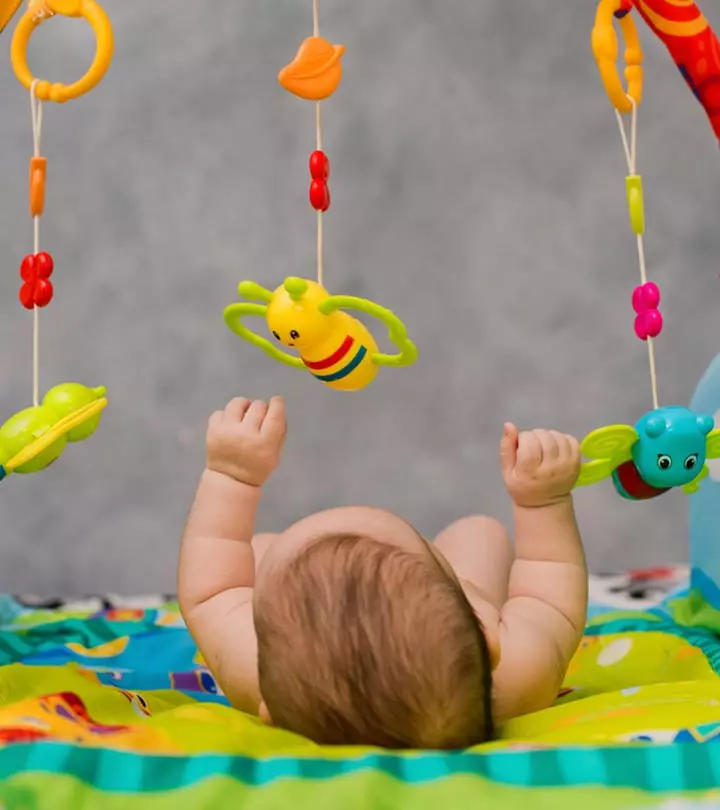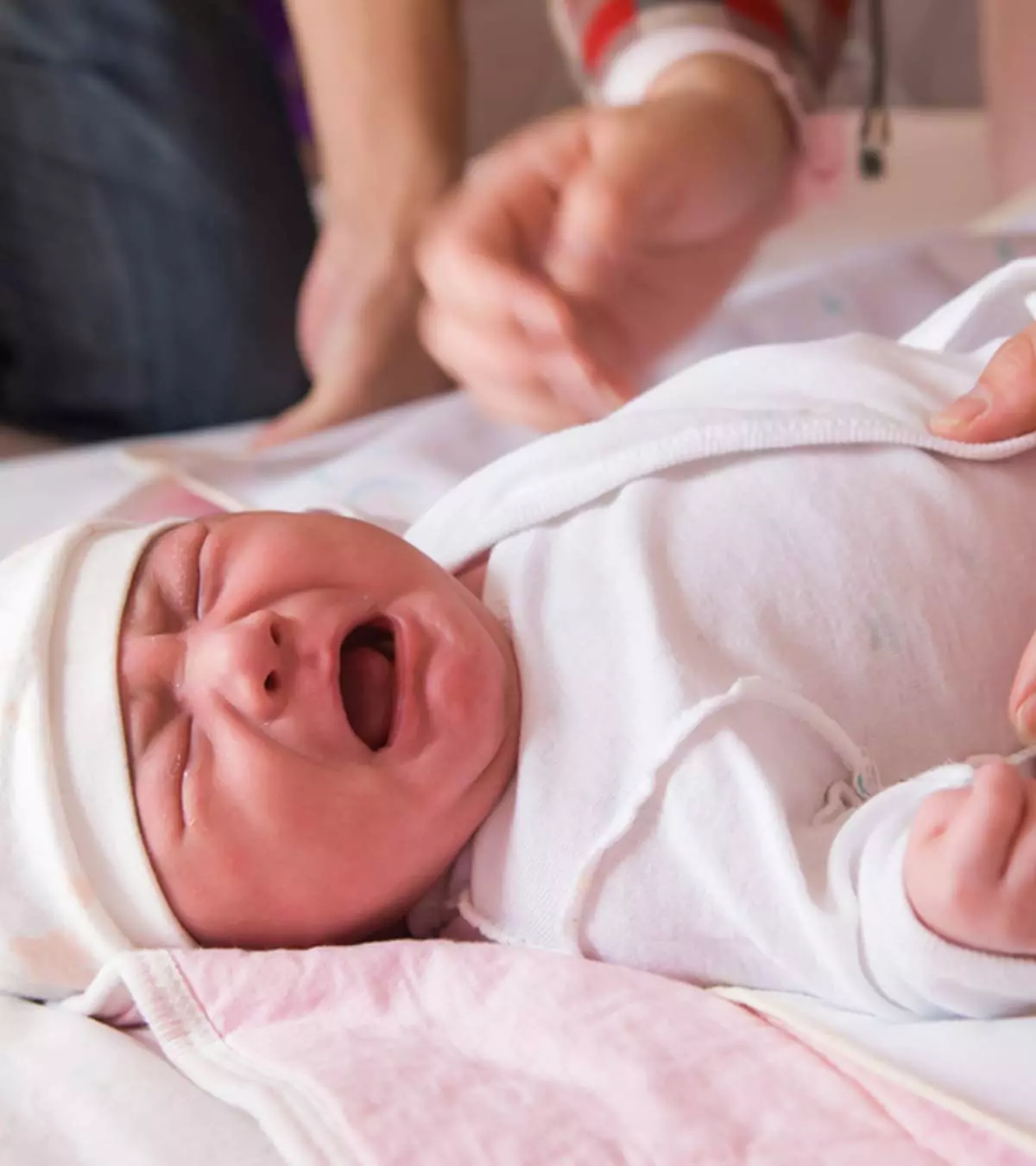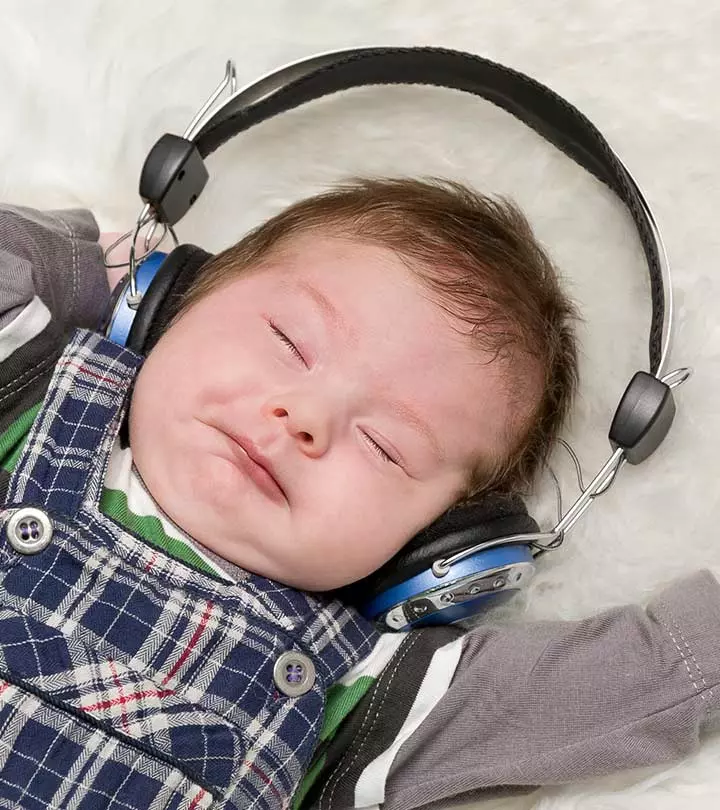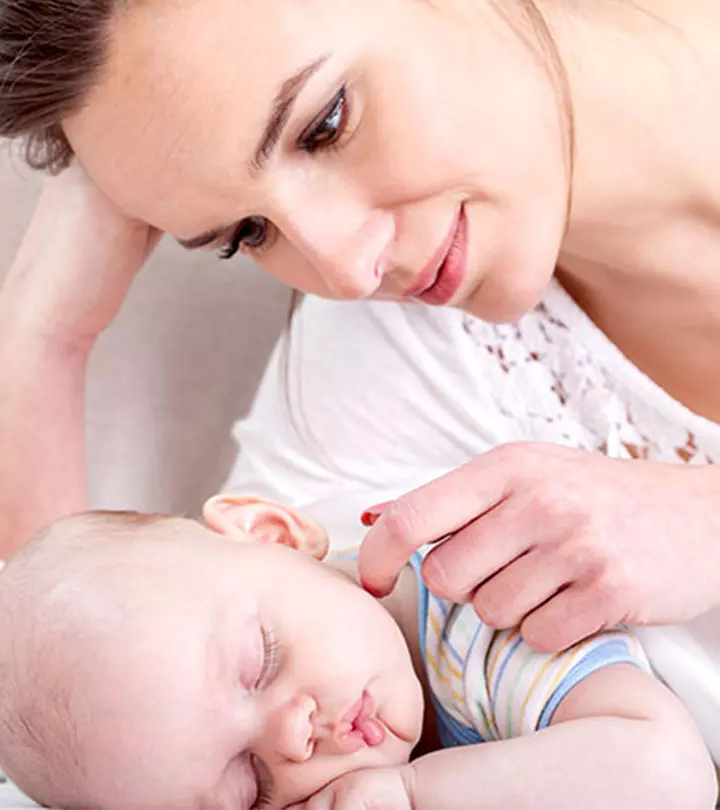
Image: Midjourney/ MomJunction Design Team
Understanding baby body cues and their meaning is essential since babies tend to speak through gestures and body language for some time.

This is because verbal communication starts later in life; until then, you need to be aware of their actions and interpret them. Recognizing these cues can significantly enhance your bond with your little one, respond to their needs, and foster a sense of security and trust. Fortunately, this is not a language that needs certification. It is simple, and you need to spend a little time learning.
How about we give you a headstart in baby body language? Read on to know your baby’s gestures and distress calls, so that even if they may not express their thoughts verbally, you can understand and help them.
Key Pointers
- Babies can’t talk but can express themselves through their body language.
- Understanding and responding to baby’s cues helps instill their trust in the caregiver and improve their overall communication skills.
- Baby grimacingiTwisted expression of face marking pain, disgust, or amusement. , grunting, and bearing down is a common sign of baby pooping, whereas clenching a fist may indicate they are hungry or under stress.
- Arching their back, grabbing ears, banging heads, and constant kicking are a few cues babies use to convey their needs.
Why Is It Important To Respond To Baby Cues?
Babies have a little understanding of their surroundings and are dependent on their caretakers. They don’t speak verbally until the age of 12 months (1). But this doesn’t mean they don’t have things to say. They convey vital information regarding their body activities and emotions through their body language.
Initially, you may have trouble interpreting them. However, with a little observation, overtime, these indications become easier to decipher. Here’s why responding to baby cues is an essential part of caretaking and parenting:
- Your response to their cues ensures them that their emotions are acknowledged.
- An affirmative response to your baby’s cues imbibes a sense of trust, thereby creating a strong foundation for your relationship with them.
- An appropriate response to their cues also teaches them to perform the right action when they face the same problem again.
- It also helps them discover several nuances of communication and improve their overall communication skills in the long run.
Linh Dao Smooke, a mother and blogger, explains how she identifies her baby’s hunger cues. She shares, “If the baby’s lips are adequately wet, she seems satisfied and content each time you finish feeding her, and wakes up after a long sleep or naps without screaming bloody murder, that means she has enough to eat. My baby’s hunger cues are: pouty lips, moving tongue, restless head. I know she’s full if she has wet lips, turns away from nipple and has a slight sleepy dust to her face (i).
 Quick fact
Quick factVarious Body Language Cues In Babies
Most babies put out similar signals for their needs. Read on to know what each of these body signs means and your ideal response for them.
1. Arching back

Babies arching their back could indicate satiety, heartburn, coliciProlonged crying or fussiness in a baby. , or gastrointestinal reflux (2). A baby’s stomach sphinctersiA ring-shaped stomach muscle responsible for relaxing or tightening the stomach passage. are still developing, making acid refluxiDigestive disease occurring due to stomach acid flowing back to the esophagus. common among them. Babies tend to arch their backs in an attempt to stretch their stomachs and to avoid further discomfort.
If you observe this posture during feeding, pause, and comfort them for a while. You can attempt to distract them and rub their backs for a while. If the discomfort persists, consult a pediatrician.
 Point to consider
Point to consider2. Ear-grabbing
It is usually a reaction to teething or their discovery of the ear. However, ear-grabbing with fever or cold could be due to an ear infection.
Check for other signs, such as a stuffy nose or troubled sleeping, and consult a pediatrician (3). If teethingiThe process in which a baby’s first teeth develop. is the cause, provide them with teething toys for comfort.
3. Head-banging
A few babies rock their heads in a rhythmic back-and-forth movement, also termed as head-banging. It is a self-soothing technique that is mostly observed before their nap or bedtime. Although this habit wears-out on its own by the age of three years, your baby may hurt their head if they hit a hard surface (4).
Observe the time they bang their head. If it happens close to their nap time, it could just be a self-comforting technique. You can prevent any injuries by padding the cradle walls. If it happens during other times, or your baby head banging continues after the age of three years, consult a pediatrician.
4. Constant kicking

Happy and content babies kick a lot. These kicks help develop leg muscles and are a prerequisite to rolling. But if your baby is grumpy while kicking their feet, it could be an indication of discomfort. Your baby could be trying to imply a dirty diaper or a bloated stomach.
If your baby is kicking in the air due to a bloated stomach, help them burp out. You can also check the mother’s diet for foods that may trigger gassiness in a breastfeeding infant.
 Did you know?
Did you know?5. Grumpiness
If you find that your baby has become quite unsettled and grumpy after a family gathering or an activity, it could be due to overstimulation. It means that your baby is overwhelmed and requires some quiet time.
Take them somewhere quiet and try rocking them until they calm down. Try to avoid any social contact until they are calm. You may also try to play their favorite music or go out for a walk. Giving them some ‘me time’ could help calm them down.
6. Fist clenching

Babies clench their fists due to a primitive reflex termed as palmar grasp. It usually disappears between five to six months (5). Newborn babies clench their fists as a continuation of their habit portrayed inside the mother’s womb. It is a natural instinct and is also one of the signs that babies may portray when hungry or under stress.
Feed your baby to relieve their hunger and soothe them with a lullaby. If you notice that this habit is accompanied by stiff limbs or torso, or the baby continues to clench fists after the age of six months, contact a pediatrician (6).
7. Baby hiccups
Most babies hiccup a lot during their first year. This is not a cause for concern as it is often a sign of overfeeding or feeding quickly (7).
Hiccups usually subside in five to ten minutes. If hiccups are common after each feed or meal, try changing your breastfeeding position or the solid food served to the baby. Burp your baby after each feed or meal. Improper latching while breastfeeding could also cause hiccups. If hiccups persist, speak to a lactation consultant or certified pediatric dietician.
8. Arm jerks
Some babies startle and jerk their arms on hearing a loud sound or when their sleep is disturbed by a bright light. This involuntary movement is termed as Moro (Startle) reflex in babies (8). Although this habit fades out on its own, frequent arm jerks during sleep could interfere with your baby’s sleep cycle and make them tired.
If your baby is awakened by a noise, comfort them, and place them back into a crib. Maintain a quiet and comfortable sleep environment for the baby.
9. Eye-rubbing

One of the most prominent baby sleep cues is rubbing their eyes. It is their “I am ready to go to bed” cue. You may also see them yawn or notice their eyelids going droopy. Sometimes, eye-rubbing accompanied by red eyes could indicate a foreign particle, such as pollen, in their eye.
If your baby rubs their eyes and you suspect a foreign particle, use a clean and sterile gauze to clean around their eyes. If eye-rubbing persists after sleep or the baby has other symptoms, such as red eyes and fever, consult a pediatrician to check for any infections.
 Quick tip
Quick tip10. Breathing quickly
If your baby’s breathing pattern is faster than usual but still maintains a happy face, it is probably because they can’t contain their excitement. As long as their breathing pattern comes back to a normal rate, there’s nothing to be panicked about (9).
Sometimes, babies tend to breathe faster when they’re startled. During such moments, talk to them and divert their attention. If none of the usual soothing techniques work, speak to a pediatrician.
11. Scrunching the knees
It is another sign of your baby telling you that they are feeling gassy or constipated. Gassiness and constipation tend to be common among infants, and they often bring knees to the abdomen to ease the discomfort.
You could help them with these conditions by letting them burp well after feeding or massaging their tummy in a clockwise direction. Alternatively, if you are lactating, check your meal and eliminate any gas-causing foods. If this habit is accompanied by vomiting, crying, bloody stools, or fever, contact a pediatrician (10).
12. Turning the face away
A baby turning their head away could be upsetting. However, a baby may do so when they are bored or being force-fed. Another reason why babies turn their heads is to check their surroundings. By the age of six months, babies tend to turn their faces a lot to check their surroundings (11). These are all important milestones in a baby’s growth and development.
The best way to react to this is by taking them out for a walk or by starting a new activity. If your baby turns their face while being fed, it usually indicates that their tummy is full (12). Stop feeding since force-feeding could lead to overeating.
Dr. Michelle Mintz, speech-language therapist from Los Angeles, California, says, “One cue that indicates that babies are full and no longer want to be fed is when you offer them the bottle or spoonful of food, and they turn their heads away. Another cue might be them pushing away the bottle, spoon, or whatever you are giving them, with their hands. Thirdly, a verbal cue might be that they make a whining or some sort of noise that indicates a ‘no’.”
13. Sucking fingers

Sucking fingers reminds the baby of breastfeeding or bottle-feeding since their natural sucking reflex helps them latch to the breast or bottle nipple. Therefore, your baby might suck their fingers to indicate that they are hungry.
Try feeding them immediately after they start sucking their fingers. If your baby sucks at fingers even after feeding, it could be a self-soothing technique. You can offer a pacifier as an exercise for baby sucking reflex for self-soothing (13).
14. Baby grimacing, grunting, and bearing down
It is a common sign of a baby pooping. You can help them relax during pooping by rubbing their bellies gently. If your baby cries while pooping, check their poop. It could be baby constipation (14).
Constipated babies could benefit from exercises, such as cycling of legs, which stimulate the intestines. If the baby is being breastfed, analyzing the mother’s diet could help find the cause. If your baby grimaces before passing bloody stools, consult a pediatrician promptly.
Frequently Asked Questions
1. Does a baby smacking lips mean that they are hungry?
Yes, your baby’s smacking lips could be an indication that they are hungry (17). However, it may also signify self-soothing behavior.
2. Does spit-up mean overfeeding?
Babies usually spit up after they swallow some air with breastmilk or formula. They have very small stomachs that are unable to hold a lot. However, overfeeding may also cause babies to spit up (18).
3. Why do babies move their hands while breastfeeding?
Hugging the breast with hands may help babies stabilize their neck and shoulder girdle. Infants may push and pull the breast with their hands to shape it and provide easier access to the nipple (19).
4. What do baby hand gestures mean?
Your baby shows you how they feel or what they want through various cues and body language. Hand gestures such as hand-to-mouth activity (with or without sucking movements), clasped hands, grasping onto your finger or an object, and smooth hand and arm movement usually indicate that they like their environment. Salute, finger splay, and jerky movements may indicate stress (20).
Baby body cues and their meanings may have a lot to do with their requirements–from wanting more milk to having insufficient or disrupted sleep–and your interpretation of their expressions and gestures and responsiveness to cues are crucial. You must pay attention to their body language to understand what they require from you. Don’t worry if you are unable to figure out their cues. Keep observing and soothing them, and you will gradually develop a strong bond and attachment with them.
Infographic: What Is Your Baby Trying To Tell You?
Babies use their facial expressions and body movements to communicate with their caregivers during their first year. This infographic can help you understand babies’ most common and prominent body language cues and what they could be trying to express.
Some thing wrong with infographic shortcode. please verify shortcode syntax
Illustration: Different Baby Cues And What They Mean
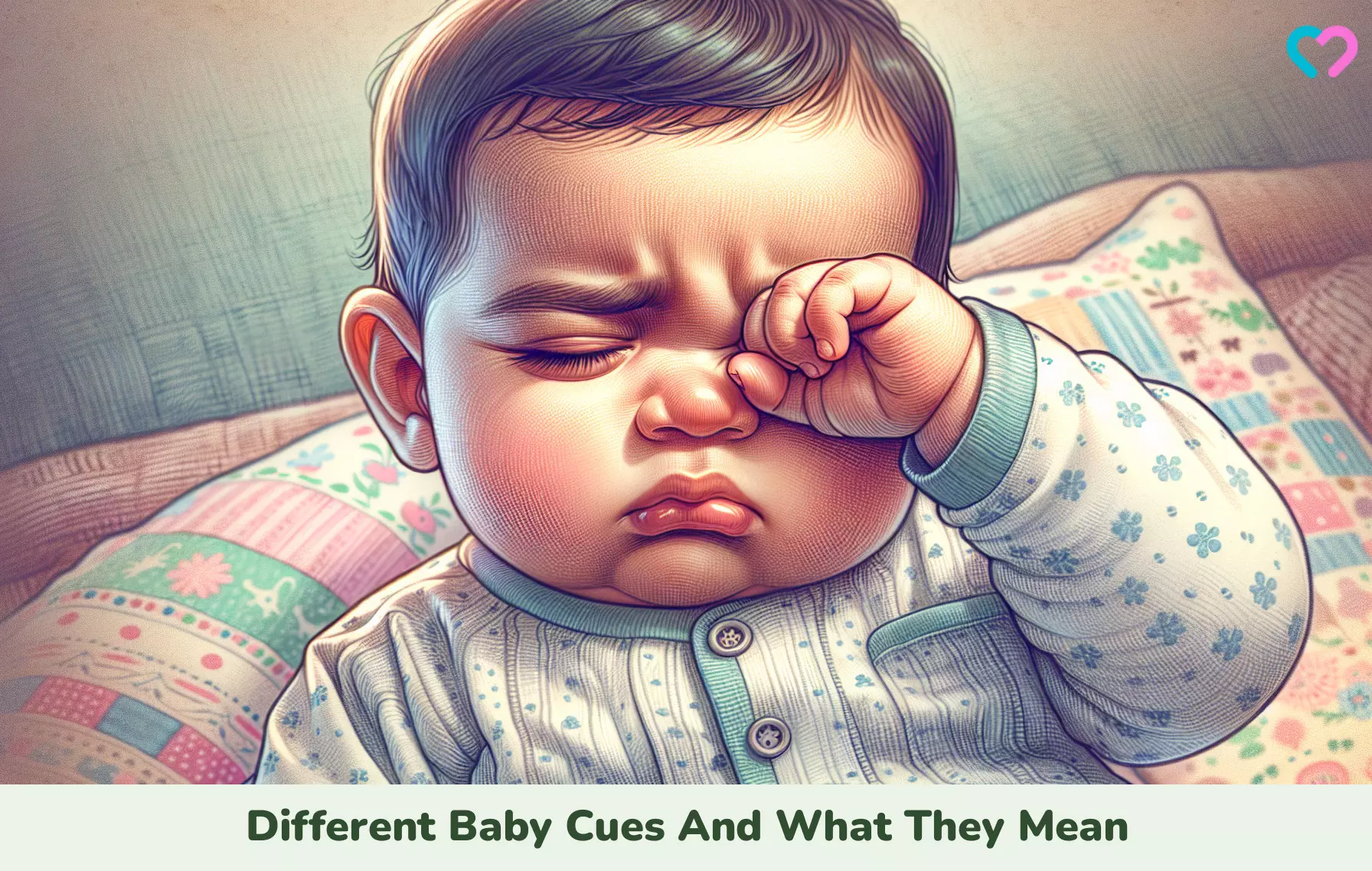
Image: Dall·E/MomJunction Design Team
Learn how to understand your newborn’s cries and figure out what they’re trying to tell you. Get ready to decode your baby’s language!
Personal Experience: Source
MomJunction articles include first-hand experiences to provide you with better insights through real-life narratives. Here are the sources of personal accounts referenced in this article.
i. My daughter sleeps through the night since 6 weeks old and so can yourshttps://medium.com/fit-yourself/my-daughter-sleeps-through-the-night-since-6-weeks-old-and-so-can-yours-7154b4a69fe9
References
1. Important Milestones: Your Child By One Year; CDC
2. Arched Back Crying Baby – What Does it Mean?; Birth Injury Help Center
3. Ear Infections in Children; National Institutes of Health
4. Babies and Head Banging at Night; Sleep Foundation
5. Newborn Reflexes; American Academy of Pediatrics
6. Cerebral Palsy in Children; Stanford Children’s Health
7. Your Baby at 1 Week; Benioff Children’s Hospital
8. Newborn Reflexes; Stanford Children’s Health
9. Breathing Problems; Stanford Children’s Health
10. Intussusception.KidsHealth
11. Important Milestones: Your Baby By Six Months; CDC
12. Is Your Baby Hungry or Full? Responsive Feeding Explained; American Academy of Pediatrics
13. Pacifiers: Satisfying Your Baby’s Needs; American Academy of Pediatrics
14. Constipation: Infant; Nationwide Children’s Hospital
15. Why Attachment Matters; University of North Carolina School of Social Work.
16. Movement Milestones: Babies 4 to 7 Months; American Academy of Pediatrics
17. Feeding Your Baby and Toddler (Birth to Age Two); University of Michigan Health
17. Baby’s Hunger Cues; USDA
18. Why Babies Spit Up; American Academy of Pediatrics
19. Research Review: Facilitating Autonomous Infant Hand Use During Breastfeeding; Lamaze
20. Cues; The Royal Children’s Hospital Melbourne
Community Experiences
Join the conversation and become a part of our nurturing community! Share your stories, experiences, and insights to connect with fellow parents.
Read full bio of Pranjul Tandon
- Dr. Michelle Mintz is a speech-language pathologist who has been working with children from birth to 5 years old for the last 25 years. She is the founder of Baby Blooming Moments, a parent coaching program available in the US and internationally. She has also authored a children's book All Done Binky!, which offers support to families with babies and toddlers weaning off pacifiers.
 Dr. Michelle Mintz is a speech-language pathologist who has been working with children from birth to 5 years old for the last 25 years. She is the founder of Baby Blooming Moments, a parent coaching program available in the US and internationally. She has also authored a children's book All Done Binky!, which offers support to families with babies and toddlers weaning off pacifiers.
Dr. Michelle Mintz is a speech-language pathologist who has been working with children from birth to 5 years old for the last 25 years. She is the founder of Baby Blooming Moments, a parent coaching program available in the US and internationally. She has also authored a children's book All Done Binky!, which offers support to families with babies and toddlers weaning off pacifiers.
Read full bio of Rohit Garoo
Read full bio of Dr. Ritika Shah
Read full bio of Ghazia Shah






